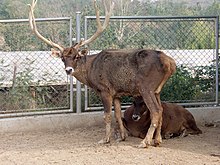| Thorold's deer | |
|---|---|

| |
| Stag (male) Thorold's deer. | |

| |
| Pair of Thorold's deer; doe (female) at left, stag (male) to right. | |
| Scientific classification | |
| Domain: | Eukaryota |
| Kingdom: | Animalia |
| Phylum: | Chordata |
| Class: | Mammalia |
| Order: | Artiodactyla |
| Family: | Cervidae |
| Genus: | Cervus |
| Species: | C. albirostris
|
| Binomial name | |
| Cervus albirostris (Przewalski, 1883)
| |
| Synonyms | |
|
Przewalskium albirostris | |
Thorold's deer (Cervus albirostris)[2] is a threatened species of deer found in the grassland, shrubland, and forest habitats, at high altitudes, of the eastern Tibetan Plateau, as well as some fragmented areas further north in central Western China.[3] It is also known as the white-lipped deer (or baichunlu, 白唇鹿, in Simplified Chinese, ཤྭ་བ་མཆུ་དཀར།་ in Standard Tibetan) for the white fur around its snout.[4]
Thorold's deer is one of the larger ungulate mammals within its range, and fills an ecological niche similar to the Tibetan red deer (or shou, the subspecies Cervus elaphus wallichi of the red deer species group). It was first scientifically described by Nikolay Przhevalsky in 1883.[1] As of early 2011, more than 100 of the deer are kept globally in Species360-registered zoos,[5] and, in 1998, it was estimated that about 7,000 remained in the wild.[1]
- ^ a b c Harris, R.B. (2015). "Cervus albirostris". IUCN Red List of Threatened Species. 2015: e.T4256A61976756. doi:10.2305/IUCN.UK.2015-2.RLTS.T4256A61976756.en. Retrieved 12 November 2021.
- ^ Pitraa, Fickela, Meijaard, Groves (2004). Evolution and phylogeny of old world deer. Molecular Phylogenetics and Evolution 33: 880–895.
- ^ Cite error: The named reference
Leslie2010was invoked but never defined (see the help page). - ^ Wilson, D. E.; Reeder, D. M., eds. (2005). "Przewalskium albisrostris". Mammal Species of the World: A Taxonomic and Geographic Reference (3rd ed.). Johns Hopkins University Press. ISBN 978-0-8018-8221-0. OCLC 62265494.
- ^ ISIS (version 12 Jan. 2011). Przewalskium albirostris.
